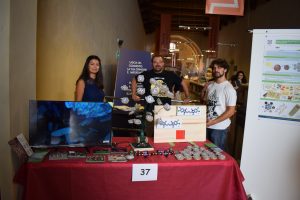A research team from the Department of Biotechnology, Chemistry and Pharmacy of the University of Siena partecipates in the PNRR project RODEO
A University of Siena research team will contribute to the project RODEO, “Rethinking Organic Materials: from Design to Efficient Optoelectronics” after a successful outcome in a cascade call promoted by IOM-CNR in the PNRR “Materials and Molecular Sciences” area of the High Performance Computing, Big Data, and Quantum Computing Research Centre.
The project, developed with partners at the University of Piemonte Orientale, was 1st classified, funded with 290.000 €, half of which will be allocated to the team in Siena.

“The objective of the project – explains prof. Daniele Padula, coordinator for the University of Siena – is to enhance predictions of the performance of devices crucial for energy storage and low-energy consumption, such as solar cells and OLED displays based on organic molecules, without any a priori knowledge other than the chemical structure of the active constituents. The challenge consists in accurately taking into account all the processes that are critical for the energy conversion process, from light to electricity (or vice versa), which occur in such organic molecules. Eventually, we aim to replace the experimental trial-and-error process that is the foundation of the discovery of new, more efficient materials with computer simulations, saving time and resources”.
The project is built on Padula’s expertise on computational materials chemistry, developed during postdocs in the UK and Switzerland, and computational spectroscopy, obtained during his PhD in Pisa, and will advance results obtained during the past years at University of Siena, funded by a Rita Levi Montalcini and a PRIN grant.

The team in Siena will greatly benefit by the expertise of Prof. Luca De Vico in computational chemistry, as demonstrated by his leading role in the development of the OpenMolcas quantum chemistry software, and 2 postdocs, Marco Campetella and Stefano Vaghi, who will join the unit to implement computational methods aimed at studying the competition among different photophysical processes.
The project will span almost all 2025, finishing at the end of November. By then, the team will produce several different computational strategies to shed light on the molecular parameters that affect photophysics and charge migration in devices, exploiting quantum and/or classical physics, suggesting chemical modifications to replace currently used materials with more efficient ones.
“The close collaboration with University of Piemonte Orientale – prof. Padula adds – will take form in the implementation of the new theoretical frameworks developed in Alessandria into computer codes that will be distributed for use within the scientific community, to tackle the problems here described”.
The topics object of this research will be extensively discussed in a Symposium taking place in Siena in February, and devoted to the modelling of Organic Materials for Optoelectronics.

